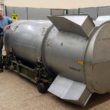Despite scientific findings linking low-level radiation exposure and cancer that go back as far as Madam Marie Curie in the 1930s, the nuclear power industry in the U.S. has evaded rigorous examination of the risks its plants pose to their neighbors and downwinders.
Senator Ted Kennedy demanded a study of cancer risks 27 years ago. For an industry that has been splitting uranium atoms to heat water and create electricity since 1957, one study hardly seems adequate. A second study is pending, but industry watchdogs worry it is so compromised that its results will be predictable.
Last year, the National Academy of Sciences (NAS) Nuclear and Radiation Studies Board issued a “Phase 2 pilot planning report.” The report was designated “planning” because executives at the agency have yet to decide how to conduct the study.
The current federally-sponsored study of cancer rates near nuclear plants is now nearly six years old, and will take at least five more years, maybe more, to complete. The planning is being shaped by regulators closely aligned with an industry that stands to lose if nuclear energy plants are linked to cancer.
The current study of cancer rates near nuclear plants is now nearly six years old, and will take at least five more years, maybe more, to complete. The planning is being shaped by regulators closely aligned with an industry that stands to lose if nuclear energy plants are linked to cancer.
To appreciate how flawed the process has been, a little history is needed. The building of nuclear power plants in the U.S. began in 1943 to produce atomic bombs. It was not until 1957 that plants began to produce electricity. In the 1980s, the number of power reactors peaked at 112. That is now 99 and falling.
Despite known releases of radiation from these reactors into the environment and a connection between radiation exposure and cancer that is now widely accepted among medical researchers, federal officials spent decades declaring no risk of developing cancer to anyone living near a reactor—without conducting any studies to support their claims.
That ended in 1988 when Ted Kennedy wrote a letter to James Wyngaarden, director of the National Institutes of Health. Kennedy had learned of an article in the medical journal The Lancet describing high leukemia rates around the Pilgrim Nuclear Power Station near Boston. Wyngaarden took the senator’s not-so-subtle hint, and responded three weeks later:
“The National Institutes of Health is actively involved in studying the adverse effects of ionizing radiation, and we concur with your view that the risks at low levels need further clarification … We are currently correlating county mortality data from the 1950s through early 1980s with reactor operations.”
Wyngaarden wasn’t truthful about his staff “currently correlating” cancer data. No such process had begun until Kennedy’s letter arrived. Wyngaarden also demonstrated his pro-industry bias by writing: “The most serious health impact of the Three Mile Island (TMI) accident that can be identified with certainty is mental stress to those living near the plant, particularly pregnant women and families with teenagers and young children.”
Following Kennedy’s request, the National Cancer Institute issued a report in July 1990, concluding: “The survey has produced no evidence that an excess occurrence of cancer has resulted from living near nuclear facilities.” Researchers, however, for the most part only surveyed cancer deaths, not incidences, thus limiting the consideration of radiation-sensitive cancers like thyroid and child cancer, which most victims survive. The safety of nuclear plants was subsequently ignored by officials except when they cited the 1990 report as evidence that it is “safe” to live near nuclear plants.
Then in May 2009, seemingly out of nowhere, the Nuclear Regulatory Commission (NRC) posted a “pre-solicitation” notice for experts to conduct a cancer study near U.S. nuclear plants.
As encouraging as that might appear, an NRC-sponsored study of cancer risks near the reactors it regulates is a blatant conflict of interest. Approximately 90 percent of NRC funding comes from licensing fees paid by companies that own the nuclear plants that the commission regulates. Bad news about cancer and nuclear plants means bad news for the Nuclear Regulatory Commission.
Moreover, NRC officials do not have medical backgrounds. They are mostly physicists and engineers, typically moving through the revolving door connecting the regulatory community and the industry. Most employees either have worked at nuclear plants or they will work at nuclear plants when they leave the agency.
To direct the study, the NRC approved a no-bid contract to the Oak Ridge Institute for Science and Education. Located at the world’s oldest nuclear weapons plant, the institute has extensive contracts with the U.S. Energy Department, which is strongly invested in nuclear development.
That conflict was too obvious. After protests by activists, Massachusetts Senator Ed Markey intervened and the NRC responded by moving the study to the National Academy of Science, whose National Academy Nuclear and Radiation Studies Board would direct the project.
The Radiation Study Board’s chair was Richard Meserve, himself a former NRC chair—and an illustration of how compromised our nation’s nuclear regulators are.
Meserve has been a senior counselor to a law firm that works for the nuclear industry, a board member of nuclear energy companies in Texas and California, and board advisor to a French-U.S. conglomerate with plans to build new nuclear plants in the U.S.
Protests by anti-nuclear activists compelled Meserve to recuse himself from the project. Yet while other members of the study board are not as compromised as Meserve, few have backgrounds in public health or medicine, and none has ever published a peer-reviewed article on cancer near nuclear plants.
By now critics of this process expect a report that finds “no link” between cancer risk and living in proximity to a reactor.
Yet science uncompromised by relations with the industry has reached a different conclusion. At least 60 published, peer-reviewed studies have linked cancer to low-level exposure to radiation (particularly among children who are most susceptible).
Examples? A 2012 study of all nuclear plants in France found elevated levels of child leukemia in the vicinity of the plants. A 2008 study in Germany came to a similar conclusion regarding child leukemia and that country’s nuclear generating facilities.
A study in Archives of Environmental Health in 2003 found cancer rates in children that were 12.4 percent higher than nationwide occurrences in 49 counties surrounding 14 nuclear plants in the eastern U.S. (Note: The author was one of the five researchers.)
The obligation among government employees and scientists to maintain their objectivity and to protect human health is on the line with this upcoming study. That unbiased research is unlikely unless grassroots organizations and individuals keep the pressure on elected officials.
Janette Sherman is a physician and author, specializing in toxicology and chemical- and radiation-related illnesses.







About month ago nuclear-sceptic sci community conducted critical discussion about published concept NAS risk around NPPs. Our common understanding: the National Academy obviously afraid to reveal the truth.
Among flaws of NAS design of studies:
– NAS do not intend to study within 5-km (the KiKK (German) and other studies have shown quite clearly that any cancer increases are limited to within 5 km of NPPs);
– NAS do not intend to study children under 5 years of age (expanding the study to 15 years will result in diluting any increases in the younger age group);
– NAS do not intend to study differencies between boys and girls cancer cases (boys are more radiosensitive wrt leukemia)
– NAS do not intend to study malformations and low body weight (such statistics exist);
– NAS do not intend to analyze the Rose of the Winds around NPP;
– It is ridiculous to base such investigation on the dubious dose estimation based on NPP effluent data release (when exist more objective measurement of irradiation);
It’s hard to avoid the thoughts that NAS are determined (a) not to learn from other studies, and (b) not to find negative impact of NPPs.
This future NAS study is “policy-led science, not “science-led policy”.
From one conclusion : “The only scientific reason to conduct studies of cancer around nuclear facilities is to evaluate whether radiation dose to neighboring populations result in a detectable increase in cancer risk. It is not logical to test a hypothesis of elevated cancer near facilities if it is decided a priori that results cannot be interpreted as evidence in support of the hypothesis. Such an exercise would amount to a public relations effort masquerading as a scientific study.”